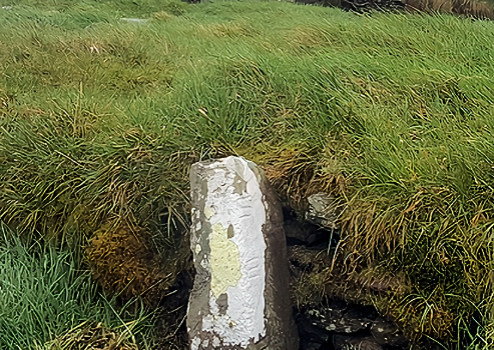Type: Ogham Stone
Townland: Aglish Church

Aglish church site (KE054-032001-) and graveyard (KE054-032002-). This is a probable early church site with 2 ogham stones (see also CIIC 141) and a bullaun discovered in the graveyard. No trace of a church survives. (Cuppage et al, 258).
MonumentFind location probably the original site.
Still in the graveyard, standing beside one of the tombs.
'Grit' (Macalister 1945, 138). 0.90m x 0.25m (Cuppage et al, 258-9).
As noted by Macalister (1945, 138-9, this stone is badly damaged: 'the dexter angle has been intentionally defaced, great flakes having been hammered off from it... Both ends of the stone are broken-off'.
The 3d model of this stone is incomplete due to its partial inaccessibility in situ.
Inscription cut (not pocked) on two angles (Macalister 1945, 138). None of the vowels of Macalister's reading are clear. He also mentions 'distal ends of an N' on the dexter angle but there is no sign of these on the 3d model, or indeed of the inital C of CELI, although this could now be below ground level. The single score on the H-side at the end of the inscription where the stone is broken at the top, could be the first score of a D, T, C or Q.
Transcription[ ... CE]L[I A]V[I V[U]Ḍ?̣
Translation'... follower of the descendant of F?...'.
CommentaryAll that survives of this inscription are the possible remains of two formula words (CELI'companion, follower' and AVI 'grandson, descendant'), followed by the beginning of a personal name. This unusual comination of formula words is also found in an ogham inscription on a stone from Drom Lócháin, Lócháin's Ridge Co. Waterford (CIIC. 275).
ReferencesBennett I. and Uí Shíthigh B. (1995): Ogham Stones of the Dingle Peninsula. Ballyferriter, p. 20.
Cuppage, J. et al (1986): Archaeological Survey of the Dingle Peninsula. Ballyferriter, p 258-9.
Hitchcock, R. (1848): 'An account of the discovery of Ogham Stones presented by Mr. Richard Hitchcock', PRIA 4 (1847-50), pp 271.
Macalister
, R.A.S. (1945): Corpus inscriptionum insularum Celticarum, p 138-9.